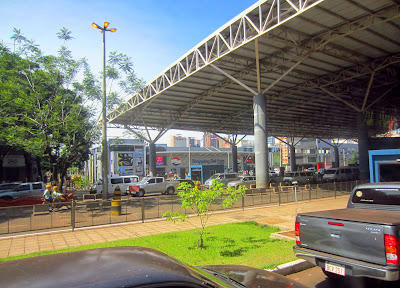I must admit that I was a little nervous. After all, my plan was to enter in both Paraguay and Brasil illegally, that is, without going through customs and immigration, and without paying the "reciprocity fee" of 160 USD that Canadians are required to pay to enter legally in Paraguay, nor getting the expensive (~80 USD) visa Canadians must get to legally enter Brazil.
At any rate, the bus I was in looked like a typical city "colectivo". Judging from the looks of the people on board, I was the only passenger who wasn't from a Mercosur country (that is, the only one who would normally have needed to do something special to get into Paraguay). We picked up a few more passengers on our way to the Argentinian border exit control. For some reason, all the countries in South America I've been to control not only entries but also exits. Because of this (and to re-enter Argentina upon return), I brought my passport. At the border control, we all went off the bus, got our papers inspected and/or passports stamped and then were promptly on our way.
Back on the bus, we crossed the Iguazu river over a bridge and into Brazil. I was nervous at that point because I feared we would be controlled at the Brazilian border as well. However, since our bus was headed to Paraguay and was not meant to make any stops in Brazil, we simply entered the country without stopping at the border. This is all very lax and people can and do stop in Brazil all the time. So, if you are in Argentina and want to go to the Brazilian side of the Iguazu Falls (without paying for a Brazilian visa), you can simply take the bus to Paraguay from Puerto Iguazu (in Argentina) and get off in Foz do Iguaçu (in Brazil).
But my intention was to go to Ciudad del Este in Paraguay first and then go to the Brazilian side of the Iguazu falls. Therefore, I enjoyed reading the signs in Portuguese while in Brazil until we reached the Puente de la Amistad (Friendship Bridge) which links Brazil to Paraguay. Actually, most of the trip from Argentina to Paraguay takes place in Brazil. Crossing over the bridge is slow as it is chock full of cars, trucks and buses, many of them making their way across to benefit from the lower prices and taxes in Paraguay. That border crossing is a real joke. So many people cross that bridge, but few (if any) get controlled at the border. The bridge is a huge conduit for smuggling (either of legal goods to avoid duty fees, or of outright illegal goods). I got in Paraguay without needing to do anything particular. Just like everybody else, I just got in.
 |
| Shopping starts right at the border in Paraguay |
From what I experienced in Ciudad del Este, I'd venture to say that Paraguay is a crap country. Once inside the country, some of the passengers on my bus got off (before we got to the bus station) with contraband they had stashed under their seats. One lady had enough stuff to fill a car. I'm guessing those goods are later headed to Brasil. Later, after completing the trip, I saw people living in squalid conditions around the bus station. These people were living in dwellings constructed out of discarded wooden pallets and garbage bags. Going back to the center of the city (which is basically where the bridge to Brazil is located), I saw hordes of people peddling cheap products and/or knockoffs everywhere. This is the kind of place where taking the bus means people come in and try to push crap products on you or beg money from you at about every city block and where walking around means it's likely you'll stumble upon a dirty child flat out sleeping on the pavement of a sidewalk. It's also worth noting that US dollars, Argentinian pesos, Brazilian reais and Paraguayan guaranis are accepted as currencies of payment for just about everything.
 |
| Ciudad del Este |
When I grew tired of the chaotic poverty and of the hustle and bustle, I decided it was time for me to head to Brazil to see the Iguazu Falls from that country's side. As I was walking my way to cross back over the bridge, a motorcycle taxi driver approached me and asked me if I wanted a ride to cross. He asked for 5 Brazilian reais or 3 US dollars. I'm sure I could have haggled over the price, but for such amounts, I didn't feel like bothering. So I donned a helmet and we zig-zagged through the traffic over the bridge, avoiding other motorcycles going in all directions, and circumventing trucks and cars. I must confess that I held on tight as some of the maneuvers my driver did seemed quite dangerous for the North American driver that I am. On a few occasions, I also felt my clothes and my boots touch cars. There was no border control back into Brazil. One has to wonder why Brazil is so open at that border. So much tax revenue is lost on smuggled goods.
Once in Brazil, I hopped on a bus that took me to the urban transit terminal next to the Bosque Guarani Zoological Park in Foz do Iguaçu. From there, I took bus 120 straight to the falls (for less than 2 USD). Before doing so, however, I went to an ATM, got some Brazilian reais and changed most of them to Argentinian pesos at a rate way better than the official one (as Argentina artificially maintains the exchange rate for its currency at nearly double its real worth). I was happy to be back in a country where the government is not interfering so recklessly with the economy.
My dealings with the local population in Brazil were confusing in this sense that after a month of being in Spanish-speaking countries, my mind is used to interpreting and expressing itself in the language of Cervantes. Brazil, with its Portuguese, was similar enough yet different enough to mess up with my Spanish. That was interesting.
 |
| Iguaçu Falls (Brazilian Side) |
Anyway, I visited the falls and played with some coatis. Then it was time to go back to Argentina. I took another "Cruzero del Norte" bus right next to (but not in) the urban transit terminal in Foz do Iguaçu. Thankfully, there was a tourist information desk at the transit terminal that pointed me to the stop. As the bus made its way back, I was nervous again. Would there be problems at any border? When we exited Brazilian without stopping at the border control, I felt a bit lighter. Again, since that bus is not really meant to stop in Brazil, no checks are made from the authorities of that country.
 |
| Coatis |
There was only one hurdle left: Argentinian immigration. As I said before, normally countries in South America stamp you out when you leave them. I was afraid the Argentinians would ask me where I had been after I left the country and give me trouble. To make it easy for the lady at the counter and to not give her too much time to think about my case, I prepared all my papers neatly and opened my passport at the page where my last Argentinian exit stamp was. Typical of border agents, she had an austere look on her face. After seeing my exit stamp, she proceeded to go through my passport page by page, examining each of them carefully. Then, she asked her colleagues to come and look at my passport. At that point, I was tense and was preparing to get grilled. But then she said in Spanish to her co-workers, "The new Canadian passports are pretty cool; they have different pictures on each page"!
That was it; there was no problem at all! I felt relieved and moved on with a warm, fuzzy feeling inside. After I got back in Puerto Iguazu, it started pouring cats and dogs. Thankfully I didn't have the rain bothering me during that adventurous day. As usual, the gods had been with me all along.
